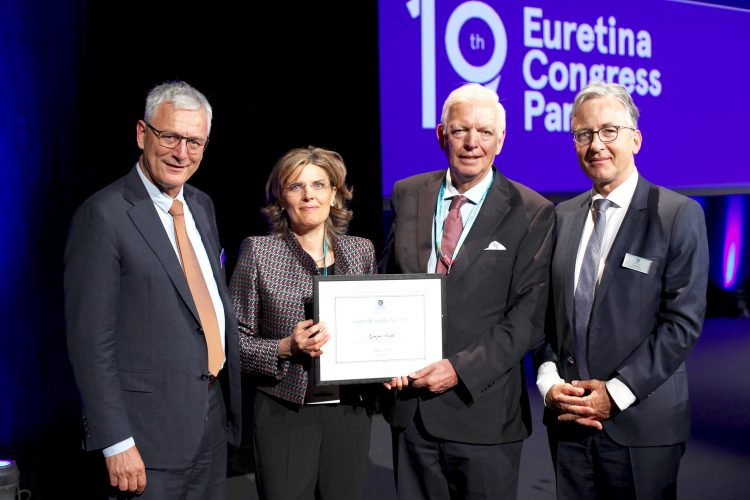Surgery in Exudative AMD
Vitreoretinal surgery still has a fundamental role to play in managing patients with advanced AMD

Dermot McGrath
Published: Sunday, September 8, 2019
 IN an era when intravitreal anti-VEGF is the mainstay of treatment in age-related macular degeneration (AMD), vitreoretinal surgery still has a fundamental role to play in managing patients with advanced disease, according to Grazia Pertile MD, who delivered the annual Gisbert Richard Lecture at the 19th EURETINA Congress.
“This is rescue surgery so obviously the indications for surgery are quite limited. Surgery can be considered when anti-VEGF therapy does not achieve an adequate response and the patient continues to lose vision, or when the complications of CNV cannot be managed with intravitreal injections alone such as a tear in the retinal pigment epithelium or in the presence of subretinal haemorrhage,” she said.
In her lecture entitled “Surgery in Exudative AMD: Functional and Physiopathological Implications”, she explained that two of the principal surgical options for advanced AMD include full macular translocation (FMT) and autologous choroidal transplantation.
FMT permits the relocation of the diseased macula on to an area of unaffected retinal pigment epithelial and choroid, and has been successfully used to restore the anatomy and visual function in some patients with AMD when the outer retina layers are not irreversibly damaged, noted Dr Pertile.
Vision-threatening complications after FMT surgery include cystoid macular oedema (CME), retinal detachment, proliferative vitreoretinopathy (PVR) and macular hole. She added that the presence of the external limiting membrane (ELM) seems to be the most reliable factor in predicting the functional outcome.
Vision-threatening complications associated with choroidal transplantation include late or no revascularisation of the graft, postoperative subretinal haemorrhage, retinal detachment with or without PVR and macular hole.
Although fast reperfusion of the choroid is a sign of successful surgery, a delay in reperfusion may lead to retinal damage and poor outcomes. She added that RPE contiguity after autologous choroidal graft also seems to be a protective factor against atrophy progression, whereas any area of damaged or absent RPE tends to enlarge over time.
In trying to decide which surgical strategy to adopt, Dr Pertile said that FMT works best in patients with low best-corrected visual acuity in the fellow eye, with a subsequent risk of diplopia, as well as those with a healthy RPE-choroid area in which to relocate the macula. Choroidal graft may be considered in other cases that do fall into these particular categories.
IN an era when intravitreal anti-VEGF is the mainstay of treatment in age-related macular degeneration (AMD), vitreoretinal surgery still has a fundamental role to play in managing patients with advanced disease, according to Grazia Pertile MD, who delivered the annual Gisbert Richard Lecture at the 19th EURETINA Congress.
“This is rescue surgery so obviously the indications for surgery are quite limited. Surgery can be considered when anti-VEGF therapy does not achieve an adequate response and the patient continues to lose vision, or when the complications of CNV cannot be managed with intravitreal injections alone such as a tear in the retinal pigment epithelium or in the presence of subretinal haemorrhage,” she said.
In her lecture entitled “Surgery in Exudative AMD: Functional and Physiopathological Implications”, she explained that two of the principal surgical options for advanced AMD include full macular translocation (FMT) and autologous choroidal transplantation.
FMT permits the relocation of the diseased macula on to an area of unaffected retinal pigment epithelial and choroid, and has been successfully used to restore the anatomy and visual function in some patients with AMD when the outer retina layers are not irreversibly damaged, noted Dr Pertile.
Vision-threatening complications after FMT surgery include cystoid macular oedema (CME), retinal detachment, proliferative vitreoretinopathy (PVR) and macular hole. She added that the presence of the external limiting membrane (ELM) seems to be the most reliable factor in predicting the functional outcome.
Vision-threatening complications associated with choroidal transplantation include late or no revascularisation of the graft, postoperative subretinal haemorrhage, retinal detachment with or without PVR and macular hole.
Although fast reperfusion of the choroid is a sign of successful surgery, a delay in reperfusion may lead to retinal damage and poor outcomes. She added that RPE contiguity after autologous choroidal graft also seems to be a protective factor against atrophy progression, whereas any area of damaged or absent RPE tends to enlarge over time.
In trying to decide which surgical strategy to adopt, Dr Pertile said that FMT works best in patients with low best-corrected visual acuity in the fellow eye, with a subsequent risk of diplopia, as well as those with a healthy RPE-choroid area in which to relocate the macula. Choroidal graft may be considered in other cases that do fall into these particular categories.
Tags: exudative amd
Latest Articles
Towards a Unified IOL Classification
The new IOL functional classification needs a strong and unified effort from surgeons, societies, and industry.
The 5 Ws of Post-Presbyopic IOL Enhancement
Fine-tuning refractive outcomes to meet patient expectations.
AI Shows Promise for Meibography Grading
Study demonstrates accuracy in detecting abnormalities and subtle changes in meibomian glands.
Are There Differences Between Male and Female Eyes?
TOGA Session panel underlined the need for more studies on gender differences.
Simulating Laser Vision Correction Outcomes
Individualised planning models could reduce ectasia risk and improve outcomes.
Need to Know: Aberrations, Aberrometry, and Aberropia
Understanding the nomenclature and techniques.
When Is It Time to Remove a Phakic IOL?
Close monitoring of endothelial cell loss in phakic IOL patients and timely explantation may avoid surgical complications.
Delivering Uncompromising Cataract Care
Expert panel considers tips and tricks for cataracts and compromised corneas.
Organising for Success
Professional and personal goals drive practice ownership and operational choices.